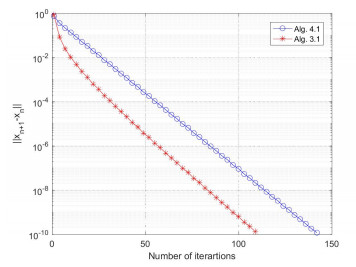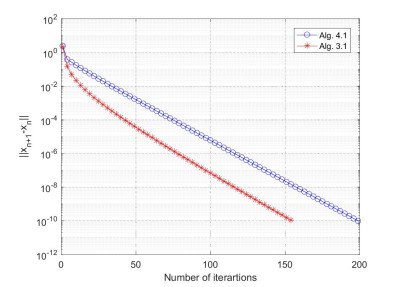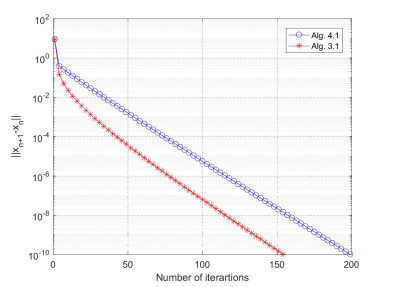1.
Introduction
The variational inequality problem (VIP) was introduced by Stampacchia [1] and provided a very useful tool for researching a large variety of interesting problems arising in physics, economics, finance, elasticity, optimization, network analysis, medical images, water resources, and structural analysis, see for example ([2,3,4,5,6,7,8,9,10,11,12,13,14,15]) and references therein.
Let H be a real Hilbert space with inner product ⟨⋅,⋅⟩ and norm ‖⋅‖, respectively. Let C be a nonempty closed convex subset of H. Let B:C⟶H be an operator.
In this article, our study is related to a classical variational inequality problem (VIP) which aims to find an element x†∈C such that
It is well known that x♯∈VI(B,C) if and only if x♯=PC(x♯−ζBx♯), where ζ>0, in other words, the VIP is equivalent to the fixed point problem (see [16]). Supposing that B is η-strongly monotone and L-Lipschitz continuous with 0<ζ<2ηL2, the following sequence {xn} of Picard iterates:
converges strongly to a point x†∈VI(B,C) due to the fact that PC(I−ζB) is a contraction on C. However, in general, the algorithm (1.2) fails when B is monotone and L-Lipschitz continuous (see [17]). In [7], Korpelevich put forward an extragradient method which provided an important idea for solving monotone variational inequality:
where f is monotone, L-Lipschitz continuous in the finite dimensional Euclidean space Rn and λ∈(0,1L).
The another motivation of this article is the split common fixed point problem which aims to find a point u∈H1 such that
The split common fixed point problem can be regarded as a generalization of the split feasibility problem. Recall that the split feasibility problem is to find a point satisfying
where C and Q are two nonempty closed convex subsets of real Hilbert spaces H1 and H2, respectively and A:H1→H2 is a bounded linear operator. Inverse problems in various disciplines can be expressed as the split feasibility problem and the split common fixed point problem. Problem (1.4) was firstly introduced by Censor and Segal [18]. Note that solving (1.4) can be translated to solve the fixed point equation:
Whereafter, Censor and Segal proposed an algorithm for directed operators. Since then, there has been growing interest in the split common fixed point problem (see [19,20,21,22]).
Censor et al. [23] first proposed split variational inequality problems by combining the variational inequality problem and the split feasibility problem. Very recently, in 2017, Tian and Jiang [24] considered the following split variational inequality problem: finding an element u such that
where T:H2→H2 is nonexpansive, B:H1→H2 is a bounded linear operator with its adjoint B∗, and A:C→H1 is a monotone and L-Lipschitz continuous mapping. Then they presented the following iteration method by combining the extragradient method with CQ algorithm for solving the (1.6):
Algorithm 1.1. Choose an arbitrary initial value x1∈C. Assume xn has been constructed. Compute
They proved that the iterative sequence {xn} defined by Eq (1.7) converges weakly to an element z∈Γ, where Γ is the set of solutions of the problem (1.6). However, Algorithm 1.1 fails, in general, to converge strongly in the setting of infinite-dimensional Hilbert spaces. We also notice that Algorithm 1.1 is involved with three metric projections in each iteration, which might seriously affect the efficiency of the method.
Motivated and inspired by the above works, in the present paper, we consider variational inequality problems and split common fixed point problems for finding an element u such that
where {Tn}∞n=1:H2→H2 is an infinite family of nonexpansive mappings, B:H1→H2 is a bounded linear operator with its adjoint B∗, and A:H1→H1 is a monotone and L-Lipschitz continuous mapping. In contrast to Tian and Jiang [24], we consider the common fixed points of an infinite family of nonexpansive mappings instead of only the fixed points of a nonexpansive mapping. The efficiency of the algorithm is also improved by removing the projection operator in the first iteration which might affect the efficiency of the method to a certain extent. Finally, we present a very simple modification to extragradient method, which makes our algorithm have the strong convergence. It is well known that the strong convergence theorem is always more convenient to use.
This paper is organized as follows: In Section 2, we give some definitions and key lemmas which are used in this paper. Section 3 consists of our algorithms and provides the strong convergence theorems. In Section 4, numerical examples are provided for illustration. Finally, this paper is concluded in Section 5.
2.
Preliminaries
Let H be a real Hilbert space with inner product ⟨⋅,⋅⟩ and norm ‖⋅‖, respectively. Let C be a nonempty closed convex subset of H. Let T:C⟶C be an operator. We use Fix(T) to denote the set of fixed points of T, that is, Fix(T)={x†|x†=Tx†,x†∈C}. First, we give some definitions and lemmas related to the involved operators.
Definition 2.1. An operator T:C⟶C is said to be nonexpansive if ‖Tu−Tv‖≤‖u−v‖ for all u,v∈C.
Definition 2.2. An operator A:C⟶H is said to be monotone if ⟨Ax−Ay,x−y⟩≥0 for all x,y∈C.
A monotone operator R:H⇉2H is called maximal monotone if the graph of R is a maximal monotone set.
Definition 2.3. An operator T:C⟶H is said to be L-Lipschitzian if there exists L>0 such that ‖Tx−Ty‖≤L‖x−y‖ for all x,y∈C.
Usually, the convergence of fixed point algorithms requires some additional smoothness properties of the mapping T such as demi-closedness.
Definition 2.4. An operator T is said to be demiclosed if, for any sequence {un} which weakly converges to u∗, and if Tun⟶w, then Tu∗=w.
Recall that the (nearest point or metric) projection from H onto C, denoted by PC, assigns to each u∈H, the unique point PCu∈C with the property:
The metric projection PC of H onto C is characterized by
for all u∈H,v∈C. It is well known that the metric projection PC:H→C is firmly nonexpansive, that is,
for all u,v∈H. More information on the metric projection can be found, for example, in Section 3 of the book by Goebel et al. (see [25]).
For all u,v∈H, the following conclusions hold:
and
Let {Tn}∞n=1:H→H be an infinite family of nonexpansive mappings and λ1,λ2,... be real numbers such that 0≤λi≤1 for each i∈N. For any n∈N, define a mapping Wn of C into H as follows:
Such a mapping Wn is called the W-mapping generated by T1,T2,...,Tn and λ1,λ2,...,λn. We have the following crucial Lemma concerning Wn:
Lemma 2.1. [26] Let H be a real Hilbert space. Let {Tn}∞n=1:H→H be an infinite family of nonexpansive mappings such that ⋂∞n=1Fix(Tn)≠∅. Let λ1,λ2,... be real numbers such that 0≤λi≤b<1 for each i≥1. Then we have the following:
(1) For any x∈H and k≥1, the limit limn→∞Un,kx exists;
(2) Fix(W)=⋂∞n=1Fix(Tn), where Wx=limn→∞Wnx=limn→∞Un,1x, ∀x∈C;
(3) For any bounded sequence {xn}⊂H, limn→∞Wxn=limn→∞Wnxn.
Lemma 2.2. [27] Assume that {αn} is a sequence of nonnegative real numbers such that
where {γn} is a sequence in (0,1) and {δn} is a sequence such that
(1) ∑∞n=1γn=∞;
(2) lim supn→∞δnγn≤0 or ∑∞n=1|δn|<∞. Then limn→∞αn=0.
Lemma 2.3. [28] Let {ϖn} be a sequence of real numbers. Assume there exists at least a subsequence {ϖnk} of {ϖn} such that ϖnk≤ϖnk+1 for all k≥0. For every n≥N0, define an integer sequence {τ(n)} as:
Then, τ(n)→∞ as n→∞ and for all n≥N0, we have max{ϖτ(n),ϖn}≤ϖτ(n)+1.
3.
Main results
In this section, we introduce our algorithm and prove its strong convergence. Some assumptions on the underlying spaces and involved operators are listed below.
(R1) H1 and H2 are two real Hilbert spaces and C⊂H1 is a nonempty closed convex subset.
(R2) B:H1→H2 is a bounded linear operator with its adjoint B∗.
(R3) A:H1→H1 is a monotone and L-Lipschitz continuous mapping.
(R4) Ω={ˆx|ˆx∈VI(A,C) and Bˆx∈⋂∞n=1Fix(Tn)}, where Ω is the set of solutions of the problem (1.8).
Next, we present the following iterative algorithm to find a point ˆx∈Ω.
Algorithm 3.1. Choose an arbitrary initial value x1∈H. Assume xn has been constructed. Compute
where {αn} is a sequence in (0,1), ςn is a sequence in (0,1L), and τn is a sequence in (0,1‖B‖2).
Theorem 3.1. If Ω≠∅ and the following conditions are satisfied:
(C1) limn→∞αn=0 and ∑∞n=0αn=∞;
(C2) 0<lim infn→∞ςn≤lim supn→∞ςn<1L;
(C3) 0<lim infn→∞τn≤lim supn→∞τn<1‖B‖2.
Then, the iterative sequence {xn} defined by Eq (3.1) strongly converges to the minimum-norm solution ˆx(=PΩθ).
Proof. Set z=PΩθ. We can obtain that
It follows from (2.1) that
We also observe that
On the other hand, we have that
Hence, we can derive that
Owing to the assumption (C2), it follows from (3.6) that
and so
which implies that the sequence {xn} is bounded. In view of (3.2) and (3.7), we obtain that
CASE I. Suppose that there exists m>0 such that the sequence {‖xn−z‖} is decreasing when n≥m. Then, limn→∞‖xn−z‖ exists. Consequently, according to the assumptions (C1) and (C3), we deduce that
In virtue of the boundedness of the sequence {Bxn} and Lemma 2.1, we get that
This together with (3.24) implies that
It follows from (3.6) that
Thanks to the boundedness of the sequence {xn}, we derive that
In view of (3.30), we can also get that
Combining (3.14) and (3.15), we obtain that
On the other hand, we get that
Hence, by (3.14), it turns out that
and consequently, according to (3.16), we have that
Next, we can take a subsequence {ni} such that
By the boundedness of the real sequence {xni+1}, we may assume that xni+1⇀x†. Since W is nonexpansive, we can derive that Bx†=WBx†(see Corollary 4.28 in [29]), that is, Bx†∈Fix(W)=⋂∞n=1Fix(Tn).
Now, we show that x†∈VI(A,C). Let
where NC(v) is the normal cone to C at v. According to Reference [30], we can easily derive that R is maximal monotone. Let (v,w)∈G(R). Since w−Av∈NC(v) and xn∈C, we have that
Noting that, due to v∈C, we get
It follows that
Thus, we can deduce that
As i→∞, we obtain that
By the maximal monotonicity of R, we derive that x†∈R−10. Hence, x†∈VI(A,C). Therefore, x†∈Ω. Since the norm of the Hilbert space H1 is weakly lower semicontinuous(see Lemma 2.42 in [29]), we have the following inequality:
and therefore
From (3.7), we observe that
Thanks to z=PΩθ and x†∈Ω, we can deduce that
Applying Lemma 2.2 to (3.23), we derive that limn→∞‖xn−z‖=0, which implies that the sequence {xn} converges strongly to z.
CASE II. For any n0, there exists an integer m≥n0 such that ‖xm−z‖≤‖xm+1−z‖. At this case, we set ϖn=‖xn−z‖. For n≥n0, we define a sequence {τn} by
It is easy to show that τ(n) is a non-decreasing sequence such that
and
This together with (3.9) implies that
Employing techniques similar to CASE I, we have
and
Since ϖτ(n)≤ϖτ(n)+1, we have
By (3.25), we obtain that
and so
By Eq (3.26), we also obtain
In the light of the last inequality and Eq (3.28), we derive that
Applying Lemma 2.3, we obtain
Therefore, we get that ϖn→0, that is, xn→z. This completes the proof. □
Algorithm 3.2. Choose an arbitrary initial value x1∈C. Assume xn has been constructed. Compute
where {αn} is a sequence in (0,1), ςn is a sequence in (0,1L), and τn is a sequence in (0,1‖B‖2).
Theorem 3.2. If ˆΩ≠∅ and the following conditions are satisfied:
(C1) limn→∞αn=0 and ∑∞n=0αn=∞;
(C2) 0<lim infn→∞ςn≤lim supn→∞ςn<1L;
(C3) 0<lim infn→∞τn≤lim supn→∞τn<1‖B‖2.
Then, the iterative sequence {xn} defined by Eq (3.29) strongly converges to the minimum-norm solution ˆx(=PˆΩθ), where
Algorithm 3.3. Choose an arbitrary initial value x1∈C. Assume xn has been constructed. Compute
where {αn} is a sequence in (0,1) and ςn is a sequence in (0,1L).
Theorem 3.3. If ˆΩ≠∅ and the following conditions are satisfied:
(C1) limn→∞αn=0 and ∑∞n=0αn=∞;
(C2) 0<lim infn→∞ςn≤lim supn→∞ςn<1L;
Then, the iterative sequence {xn} defined by Eq (3.30) strongly converges to the minimum-norm solution ˆx(=PΩθ), where ˆΩ={ˆx|ˆx∈VI(A,C)}≠∅.
4.
Numerical illustrations
In this section, we present some numerical examples to illustrate our main results. The MATLAB codes run in MATLAB version 9.5 (R2018b) on a PC Intel(R) Core(TM)i5-6200 CPU @ 2.30 GHz 2.40 GHz, RAM 8.00 GB. In all examples y-axes shows the value of ‖xn+1−xn‖ while the x-axis indicates to the number of iterations.
Example 4.1. Let H1=H2=Rn. The feasible set is defined as:
Let G:Rn→Rn is a linear operator defined by:
for all x∈Rn, where G=(gij)1≤i,j≤n is a matrix in Rn×n whose terms are given by:
It is obvious that A is ‖G‖-Lipschitz continuous. By a direct calculation, we also have that ⟨Ax,x⟩=⟨Gx,x⟩=0 and so, A is monotone. Let B be a matrix in Rn×n which is randomly generated.
Taking cognizance of the difference of the problems handled by Algorithm 3.1 and Algorithm in Tian and Jiang [24], in order to comparing these two algorithms, we make a very small modification to the one in [24] such that it can also solve the problem (1.8). The modified algorithm can be written as follows:
Algorithm 4.1.
According to the proof of Theorem 3.1, we can easily verify that this modified algorithm works for solving (1.8). The values of control parameters in these two Algorithms are ςn=12‖G‖, τn=12‖B‖2, α1=12, αn=1n(for all n≥2), λn=1n+1 and x1=(1,⋯,1)T, and the infinite family of nonexpansive mappings {Tk}∞k=1:Rn→Rn is defined by:
for all x∈Rn, where {Mk} is a sequence of diagonal matrixes in Rn×n:
The numerical results of the Example 4.1 are reported in Table 1 and Figures 1–4 by using the stopping criterion ‖xn+1−xn‖≤10−10.
Example 4.2. Let H1=H2=L2([0,1]) with the inner product:
and the induced norm:
The feasible set is defined as:
The mapping A:L2([0,1])→L2([0,1]) is defined by:
It is easy to see that
and
Therefore, the operator A is monotone and 2-Lipschitz continuous. Let Wn=I(Identity mapping). The values of control parameters for Algorithm 4.1 and Algorithm 3.1 are ςn=14, α1=12, αn=1n(for all n≥2), λn=1n+1 and x1=8t2. It can be seen easily that {xn} strongly converges to the zero vector θ(∈L2([0,1])). The numerical results of the Example 4.2 are reported in Table 2 and Figures 5 by using the stopping criterion ‖xn+1−xn‖≤ε=0.01.
Remark 4.1. The numerical results of Example 4.1 and Example 4.2 show that the performance of Algorithm 3.1 is better than Algorithm 4.1 both in CPU time and the number of iterations. Algorithm 3.1 is more effective in both finite and infinite dimensional spaces and especially in conditions involving complex projection calculations, see Tables 1, 2 and Figures 1–5. In Example 4.1, we observe that the number of iterations tends to be stable, while the CPU time increases, as n increasing.
5.
Conclusions
In the present paper, we consider variational inequality problems and split common fixed point problems. We construct an iterative algorithm for solving Eq (1.8) which can be regard as a modification and generalization of Algorithm 1.1 with fewer metric projection operators. Under some mild restrictions, we demonstrate the strong convergence analysis of the presented algorithm. We also give some numerical examples to illustrate our main results. Noticeably, in our article, A is assumed to a monotone and L-Lipschitz continuous mapping. A natural question arises: how to weaken this assumption?
Use of AI tools declaration
The authors declare they have not used Artificial Intelligence (AI) tools in the creation of this article.
Acknowledgments
This work was supported by National Natural Science Foundation of China under Grant (No. 62103289), National Natural Science Foundation of China (No. 11761074), Project of Jilin Science and Technology Development for Leading Talent of Science and Technology Innovation in Middle and Young and Team Project (No. 20200301053RQ), and Natural Science Foundation of Jilin Province(No. 2020122336JC).
Conflict of interest
The authors declare no conflict of interest.









 DownLoad:
DownLoad:








